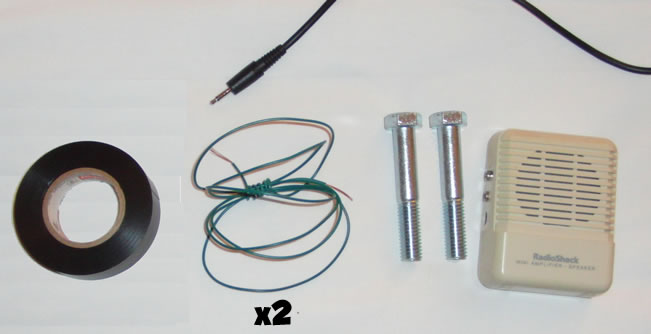| Materials |
- 2 five foot pieces of insulated 20 gauge wire. (The wire can be a similar gauge. The length is just a guess that worked for me.)
- Electrical tape. I used electrical tape because when you pull it is will conform to the wire shapes better.
- Small, portable amplifier. With an adapter you could use a guitar amp if have one. I got my small amplifier from Radio Shack (Item number 277-1008) (~$20)
|
- 2 (1 1/2 inches diameter x 2 1/2 inches long,) bolt. The diameter and length does not have to math exactly. the large bolt just makes it easier for student to see what is happening. (Available from Lowe's, Home Depot or other hardware store.)
- 6-Ft mono male to mono male audio cable. Radio Shack item number 274- (~$7.00) You could substitute item 42- 2434 It is 6 feet long and is already stripped. However, if you are making two bolts you will need two of these.
|

|
|
Instructions for building the device.
|
- Strip both ends of the 5 foot wire to expose the copper wire inside.
|
|
- Tape one end of the wire to the bolt. Leave a little hanging off the end. This piece will be used later.
|
|
- Wrap the long end of the wire near the head of the bolt. Do not wrap about 4 inches of the wire.
|
|
- Tape the 4inches of unwrapped wire to the bolt. This tape will keep the wire from coming undone.
|
|
- Cut the 1/8" mono male to 1/8" mono male cable in the middle. You will be left with 2 three foot long pieces. Inside this wire is a wire in the middle, it is wrapped in a second piece of plastic. Outside the plastic is another piece of wire. Wrapped out this is a piece of foil. Peel these pieces apart so that about 1 inch of the wire is exposed.
|
[Picture coming as soon I get a new camera cable. ] |
- Repeat this procedure for the second bolt.
|
- Plug on end of the 1/8" mono cable into the amplifier. Turn on the amplifier and turn it all the way up. You should mot hear anything. Plug the other bolt into the headphone jack into a sound source, such as an iPod. Play a song on the iPod and turn it up loud. Place the two bolts about 1/2 inch apart and you should hear the iPod through the amplifier.
|
|
How it can this used?
|
- The bolt that is connected to the amplified is an audio changing magnetic field sensor.
- Wave it around an ac/dc wall adapter (Geeks called these, "wall warts.")
- Take a strong magnet and try to move it over the bolt without making any noise. Careful the magnet will be attracted to the bolt.
- Can you move the magnet to make a rapid clicking noise?
- Can you move adjust the volume of the without touching the amplifier?
- Investigate a computer when it is one and when it is sleeping.
- What else can we look at?
|
How does it work?
|
- When a current travels through a wire it will generate a magnetic field. The corollary is also true. An alternating magnetic field will generate a current. The iPod will generate a fluctuating current. There fluctuations cause the magnetic field inside the coil to fluctuate in time with the current. The bolt is there to intensify the magnetic field. When the second bolt is held near the first bolt it responds to the fluctuating magnetic field of the first bolt, (Faraday's and Lenz's Law.) It responds by generating its own magnetic field as it tries to maintain the flux in its coil of wire. This process will generate a current that is then made louder by the amplifier.
- The wall wart, computer and magnet generate their own magnet fields that are picked up by the bolt connected to the amplifier.
|
Extensions
|
- Have the student each build one bolt. Use rubber bands instead of tape so you can reuse the components. This will give then some insight into the device,
- Make some amplifiers available for check out and have a student take one home to investigate "stuff"in their home. Have the other student develop a list of things to investigate. Have the student report back.
- Use a Vernier CBL or similar connected to the voltage probes which are in turn connected to the leads of the bolt. This can be used to quantify results. Now you can quantifiably investigate the effects of distance, speed and rate of change.
|